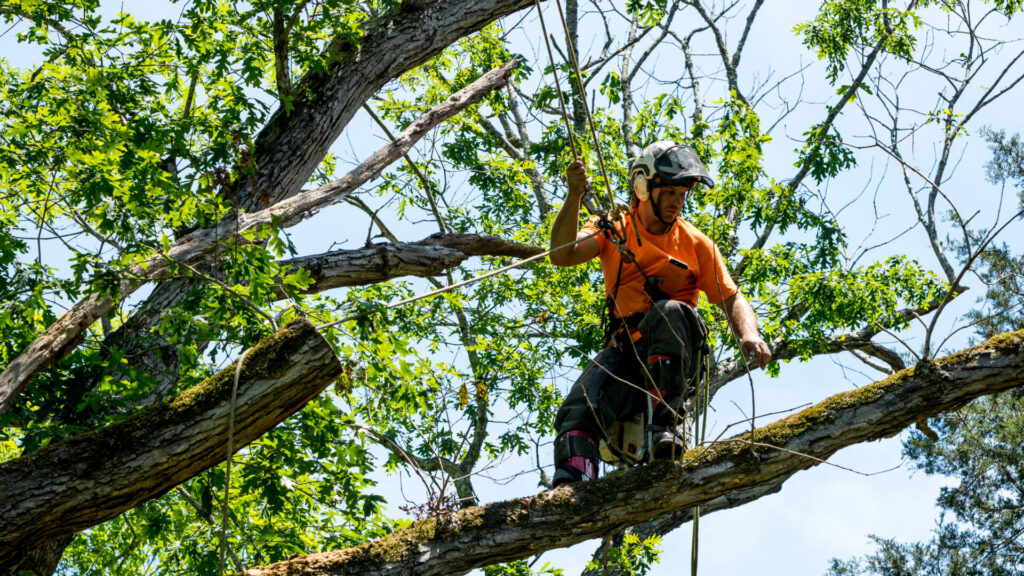Assessment
A certified arborist can be a key player on your landscaping team. Known as tree doctors, these experts undergo intensive training to become proficient in arboriculture. From saplinghood through maturity, they nurture trees with skill, armed with pruning finesse and disease diagnostics. With a keen eye for risk assessment, they safeguard both trees and property, ensuring a verdant legacy for future generations.
Proper care ensures that your trees will thrive while offering essential benefits like erosion control and wildlife habitat. However, like any living organism, trees can fall prey to injury, pests, and diseases, necessitating the need for a certified arborist to perform tree risk assessment. In this blog, we share the telltale signs of tree damage that indicate it is time for professional services.
6 Signs You Need a Certified Arborist for Tree Risk Assessment
1. Wilted or Discolored Leaves
When your tree’s leaves wilt or become discolored, it’s a distress call that shouldn’t be ignored. Whether it’s due to parched soil, lurking diseases, or nutrient deficiencies, such as iron deficiency common in oak trees, the cause needs to be identified swiftly. An arborist’s expertise is invaluable in interpreting these signals, ensuring our leafy companion thrives.
2. Unexplained Leaf Loss or Dieback
If a tree starts shedding leaves prematurely, it’s a sign of trouble. Severe cases may lead to dieback, where branches or sections stop growing and even appear to be dead. While some leaf drop should be expected, excessive or early loss indicates underlying issues which an arborist can identify.
3. Cracks, Cankers, or Cavities on the Trunk
Cracks, splits, and cavities aren’t just surface flaws; they are physical wounds on the tree and pose significant risks. Fractures can be caused by wind stress or growth expansion, compromising structural integrity. Meanwhile, cavities and decayed areas can lead to further instability and promote pest infestation. When left unchecked, decayed cavities can extend deep into the trunk, weakening the tree’s core and creating hollow areas. Especially in the early stages, an arborist can advise if and how the structural effects of these risks can be mitigated.
4. Leaning or Unstable Trees
When your trees start to lean, it’s a silent alarm bell indicating potential danger. Hidden damage or decay could be lurking beneath the surface, ready to destabilize the tree at any moment. Signs like oozing wounds, sunken bark, insect infestations, or mushroom growth require the services of a certified arborist for tree risk assessment.
5. Holes in Tree Leaves
If your tree’s leaves start sporting holes, it could hint at a serious problem. While insects like beetles and caterpillars leave limited damage, more severe infestations require treatment. But, scattered holes can also be caused by fungal diseases, such as the shot hole disease. Your certified arborist can determine which situation your tree is dealing with and how to best remedy it.
6. Signs of Decay or Rot in the Trunk or Branches
When branches break off frequently or the top of the tree fails to expand, it’s a clear sign of trouble below the surface. Yellowing leaves, brown tips, and moss or fern growth indicate root damage from internal rot. These signs point to the urgent need for an arborist’s expertise to restore the tree or strategically remove part it for safety.
Work With Well Rooted Gardens for a Safe and Thriving Landscape
Certified arborists are like nature’s detectives, with an unrivaled understanding of tree biology and behavior. They can pinpoint potential risks and recommend the best solutions, helping to ensuring your trees stay healthy and strong for years to come, or helping you to discern when it is time to remove a tree and plant a new one.
Don’t gamble with your trees’ health — choose Well Rooted Gardens for peace of mind and thriving greenery! Our experts can determine what your trees’ needs are and how to best meet them. Moreover, safety is our top priority. So, rest assured that we are looking out not only for the safety of your trees, but also the safety of people and property that might be at risk from unstable trees.
Contact us today at 402-800-7389 to safeguard your leafy companions and preserve the beauty of your landscape!

